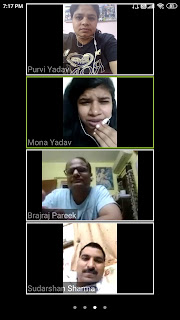Our
first online introductory workshop with the teachers on sexuality education
attracted the attention of officials from Government school paving the path for
second workshop almost immediately. With
Covid-19, where teachers are engaging with students using digital technology
but at the same time they are also seeking opportunity to enhance their own
learning. This adaptability provides a
bridge to build conversations on sexuality education which otherwise is very
nicely either ignored or imagined as non-existent especially in education
system that carries the immense burden of structured syllabus and demand of
excellent grades.
The
introductory session on sexuality education began with sharing intention for
the workshop following brief introduction about our work at Sahas. We then
invited participants to introduce themselves along with one thing that they are
grateful for during this world wide crisis.
“During
this crisis, I am so grateful that I am healthy and not fallen ill. Secondly I am
just so thankful for all the farmers because of whom not just me but so many
people are getting food to eat and survive.”
“While
the entire world is in the clutches of this dreaded disease, I am amazed by the
patience people have. People are actually being cooperative and following rules
to stay at home which seemed impossible”
In
order to build a discourse on sexuality education, we invited them to share
their experiences of having witnessed any conversations or situations or being
asked questions that made them uncomfortable or they didn’t know how to handle
the situation. The kind of response to this question didn’t surprise me but
they emphasized the strong need to have sexuality education in schools.
“There
are so many incidents that happen that I don’t know how to tackle. Sometimes
students draw inappropriate drawings on desks, bathroom walls or in notebooks.
Many a times those drawings depicts act which is questionable. There are fights
too on this drawings because some of the students mention the name of someone’s
mother on them. To cater to those complaints in front of the entire class is
very difficult. I try my best to pacify the situation, explain things but I
don’t think that’s enough.”
“There
is this curiosities towards opposite gender’s body and many a times even with
their own gender”
This
led to our next discussion on the need of sexuality education for the students.
To my surprise, the participants strongly advocated for sexuality education as
part of curriculum. One of the teacher openly shared that there must be a
course may be a short term subject that should be introduced just when these
physical changes begin so that the students can understand their body, get
answers to their curiosities and feel that this is normal and not something to
be ashamed of.
Another
teacher mentioned that subject teachers try to answer questions but they don’t
have training to cater to these questions, also they are awkward, hesitant when
it comes to engaging on curiosities related to sexuality education. These
matters are crucial, sensitive and can have deep impact on student’s life so
there should be trained teachers or designed sessions which could be helpful.
According to them, the teachers try their best but that’s not really enough.
This
workshop brought out one of the very crucial and almost cemented paradox of the
shame and stigma around sexuality education. As shared by one of the teachers,
“While we are at the topic of reproduction system, I remember my 8th
Standard where our teacher was hesitant in teaching the chapter so some teacher
who used to teach 12th standard came to teach us specific 2-3
related chapters. It was confusing and we were surprised as to why such a
senior teacher would come and teach us and why not our own teacher? And then
when in 12th, everything is in detail. Our teacher explained male
reproductive system elaborately but nothing about female system, boys had too
many questions. I am sure they were excited, can’t say the same about girls. So
our teachers asked the interested students to come to lab to discuss the
questions. It was a co-ed school so no one actually went.”
It
was important to understand that this pattern of not teaching the chapter of
reproduction system given in the book approved by education system was not
taught 40 years back, 20 years back and at present too! This is not an
observation by us, but by the adolescents, parents and now teachers themselves.
When teachers hesitate to teach what’s given in the book how in the world will
they talk about sexuality education which is much more vast and is not
restricted to sex education? It is not just because they are hesitant but are
clouded by their own fears, anxieties and assumptions that come as a package
with being in this society. Until this pattern is recognized and dismantled,
the efforts to integrate sexuality education will be a huge challenge which is
quite evident in the current scenario.
“I
didn’t understand the hesitation around teaching those chapters while I was a
student but now being a teacher it makes even less sense. Teachers need to take
a step forward, hold that responsibility and engage on these conversations. I
don’t see why they should be feel ashamed of teaching these topics, as a
teacher we have this huge duty to shape student’s life. I know questions could
be weird but we could answer them to best of our capability”
Another
thing that I loved most about this session was the openness and readiness to
learn! The teachers acknowledged that they are not fully equipped with the
tools and language to engage on the issues of gender and sexuality. At the same
time, they welcomed the idea of trainings on the sexuality education so that
they could be sensitive and open to situations and questions asked by students.


No comments:
Post a Comment